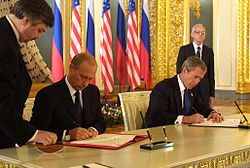- Strategic Offensive Reductions Treaty
-
Not to be confused with Strategic Arms Reduction Treaty or Strategic Arms Limitation Talks
SORT / Treaty of Moscow Treaty on Strategic Offensive Reductions 
Presidents Vladimir Putin and George W. Bush sign SORT on 24 May 2002 in Moscow Type Strategic nuclear disarmament Signed 24 May 2002 Location Moscow Effective 1 June 2003 Condition Ratification of both parties Expiration 5 February 2011
(Superseded by New START)Signatories George W. Bush
Vladimir PutinParties United States
RussiaRatifiers U.S. Senate
State DumaLanguages English, Russian The Treaty Between the United States of America and the Russian Federation on Strategic Offensive Reductions (SORT), also known as the Treaty of Moscow, was a strategic arms reduction treaty between the United States and Russia that was in force from June 2003 until February 2011 when it was superseded by the New START treaty.[1] At the time, SORT was positioned as "represent[ing] an important element of the new strategic relationship" between the two countries[2] with both parties agreeing to limit their nuclear arsenal to between 1700 and 2200 operationally deployed warheads each. It was signed in Moscow on 24 May 2002. After ratification by the U.S. Senate and the State Duma, SORT came into force on 1 June 2003. It would have expired on 31 December 2012 if not superseded by New START. Either party could have withdrawn from the treaty upon giving three months written notice to the other.
Contents
Mutual nuclear disarmament
SORT was one in a long line of treaties and negotiations on mutual nuclear disarmament between Russia (and its predecessor, the Soviet Union) and the United States, which includes SALT I (1969–1972), the ABM Treaty (1972), SALT II (1972–1979), the INF Treaty (1987), START I (1991), START II (1993) and New START (2010).
The Moscow Treaty was different from START in that it limited operationally deployed warheads, whereas START I limited warheads through declared attribution to their means of delivery (ICBMs, SLBMs, and Heavy Bombers).[3]
Russian and U.S. delegations met twice a year to discuss the implementation of the Moscow Treaty at the Bilateral Implementation Commission (BIC).
Implementation
Lawrence Livermore National Laboratory reported that President Bush directed the US military to cut its stockpile of both deployed and reserve nuclear weapons in half by 2012. The goal was achieved in 2007, a reduction of US nuclear warheads to just over 50 percent of the 2001 total. A further proposal by Bush would have brought the total down another 15 percent.[4]
Criticism
The treaty was criticized for various reasons:
- There were no verification provisions to give confidence, to either the signatories or other parties, that the stated reductions have in fact taken place.
- The arsenal reductions were not required to be permanent; warheads are not required to be destroyed and may therefore be placed in storage and later redeployed.
- The arsenal reductions were required to be completed by 31 December 2012, which is also the day on which the treaty loses all force, unless extended by both parties.
- There was a clause in the treaty which provides that withdrawal can occur upon the giving of three month's notice and since no benchmarks are required in the treaty, either side could feasibly perform no actions in furtherance of the treaty, and then withdraw in September 2012.
See also
- There have been several other treaties known as the Treaty of Moscow
- Russia and weapons of mass destruction
- United States and weapons of mass destruction
- New START Treaty
Further reading
- Nuclear Files.org Text of the SORT
Footnotes
- ^ http://www.whitehouse.gov/sites/default/files/2010%20New%20START%20msg%20rel.pdf
- ^ Letter of Transmittal: The Moscow Treaty 2002
- ^ START1 treaty hypertext US State Dept. Article II
- ^ Lawrence Livermore National Laboratories. Science & Technology Review. Monitoring a Nuclear Weapon from the Inside: Embedded sensors could help transform stockpile stewardship
Nuclear weapons limitation treaties 1963 Partial Nuclear Test Ban Treaty · 1968 Nuclear Non-Proliferation Treaty · 1972 Anti-Ballistic Missile Treaty · 1974 Threshold Test Ban Treaty · 1970s Strategic Arms Limitation Talks · 1987 Intermediate-Range Nuclear Forces Treaty · 1991 START I · 1993 START II · 1994 United States – Russia mutual detargeting · 1996 Comprehensive Nuclear-Test-Ban Treaty (not into force) · 1997 START III · 2002 Strategic Offensive Reductions Treaty · 2010 New STARTCategories:- Arms control treaties
- Nuclear weapons
- Treaties of the United States
- History of the United States (1991–present)
- Nuclear weapons governance
- Russia–United States relations
- Treaties concluded in 2002
- Treaties entered into force in 2003
- Treaties of the Russian Federation
- Presidency of George W. Bush
- Vladimir Putin
Wikimedia Foundation. 2010.
